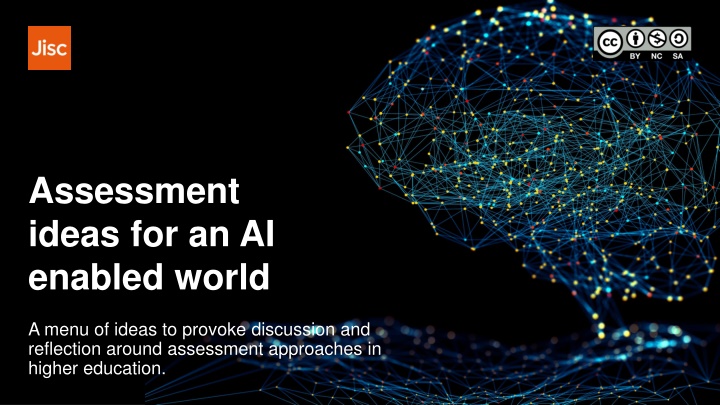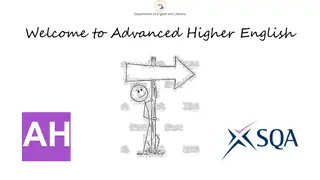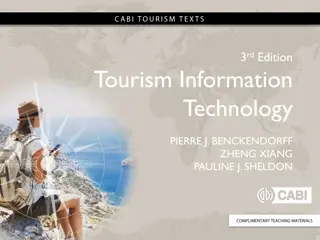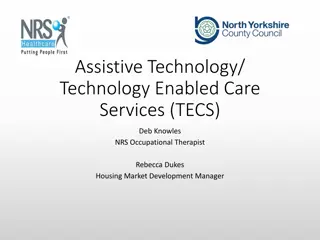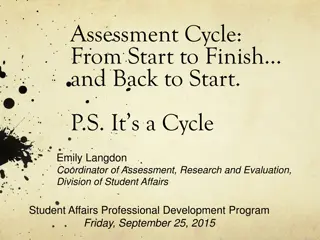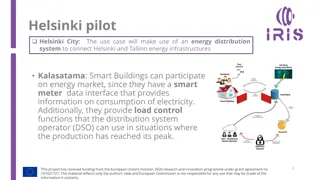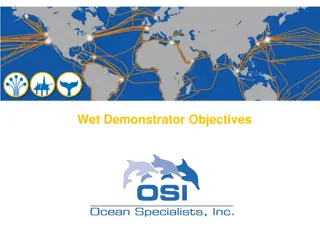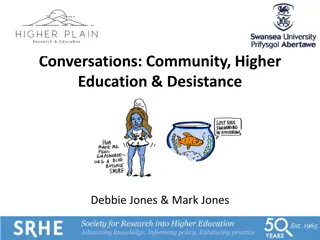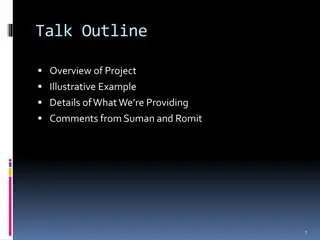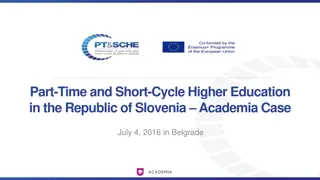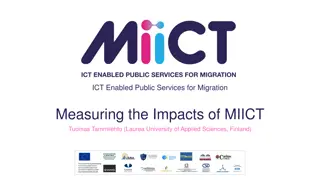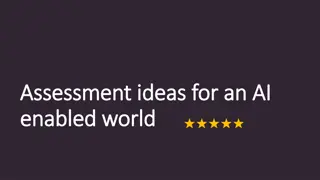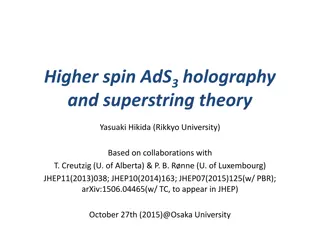Assessment Ideas for an AI-Enabled Higher Education World
Explore a menu of assessment ideas for higher education in an AI-enabled world, focusing on designing assessments to develop skills for thriving in AI environments. The resource includes assessment types, learning outcomes, formats, and suitability for various disciplines. Star ratings offer perspectives on assessment characteristics, encouraging discussion and reflection.
Download Presentation

Please find below an Image/Link to download the presentation.
The content on the website is provided AS IS for your information and personal use only. It may not be sold, licensed, or shared on other websites without obtaining consent from the author.If you encounter any issues during the download, it is possible that the publisher has removed the file from their server.
You are allowed to download the files provided on this website for personal or commercial use, subject to the condition that they are used lawfully. All files are the property of their respective owners.
The content on the website is provided AS IS for your information and personal use only. It may not be sold, licensed, or shared on other websites without obtaining consent from the author.
E N D
Presentation Transcript
Assessment ideas for an AI enabled world A menu of ideas to provoke discussion and reflection around assessment approaches in higher education.
The focus is on assessment design that enables students to develop foundational knowledge, skills and attributes that will help them thrive in an AI enabled world (with or without AI assistance). Thank you to Lydia Arnold and others for sharing ideas to include in this resource. Menu design is based on Lydia Arnold s Top trumps (2022). See end card for contributors. Menu collated and customised by Dr Isobel Bowditch, Digital Assessment Advisor, UCL, supported by Jisc National Centre for Ai in tertiary education, Pam Birtill University of Leeds, Eddie Cowling University of York, Marieke Guy UCL, Cathy Minett-Smith University of West of England, Stephen Webb University of Portsmouth.
Each card outlines: Type of assessment task Corresponding assessment type in UCL's Assessment Operating Model. See slide 4 for key The learning that it assesses and develops with reference to Bloom s taxonomy, personal and professional capabilities and AI literacy Appropriate formats Rating on some key characteristics of assessment. See slides 5 and 6 for key Where appropriate, whether the activity is suitable for specific disciplinary areas
Assessment categories The cards use six types of summative assessments/exam categories common in HE education, abbreviated as follows: Controlled Condition Exams (time limited exams in person or online - which may or may not allow for use of authorised resources). Practical Exams (practical assessments with a short, fixed duration such as presentations, group presentations, vivas, clinical exams, OSCEs, lab tests etc). Take-Home Papers / Open Book (assessments with limited duration of say 1 day to 1 week. Students are allowed access to resources). Dissertation (extended, in-depth coursework assignments involving research and independent study). Quizzes & In-class Tests (these take place in person or online and although often include MCQ type questions may also include other class activities). Coursework and other Assessments (Assignments where students are typically given a few weeks to complete the assessment). Includes essays, reports, portfolios, artefacts, exhibitions or other assessment that does not fit into other categories.
Star ratings explained The star ratings on these cards show one perspective on the characteristics of each assessment type. Users should debate and discuss these judgements and come to their own view.
The ratings relate to key areas of assessment design and priorities: Often mirroring real life, complex challenges, authentic assessments have diverse outputs and focus on process as well as product. They equip students to work with uncertainty and caused them to reflect meaningfully on their learning. Authenticity The effort required to construct or produce meaning or knowledge rather than simply re- producing meaning and knowledge as created by others. Challenge The outcome enables students to demonstrate learning by engaging in complex performance, creating a significant product or accomplishing a complex task, using higher- order thinking, problem-solving and creativity. The level of active learning students engage in during the assessment either through feedback opportunities or metacognition (learning how to learn). The manageability of different assessments in different circumstances. This could be the support students need in terms of developing certain capabilities such as AI literacy or critical thinking, providing feedback opportunities or in the assessment mechanisms. The possible impact of the assessment beyond the timescale of a programme of study and how it prepares students to meet their present and future learning needs. Product Learning Staff demand Lifelong learning
Assessment category index CCE Controlled Condition Exams OB Q Take-Home Papers / Open Book Quizzes and In-class Tests The assessment cards relate to the six categories shown here. Flick through the cards and look for ideas you might try. Alternatively, click on a category opposite to view an index of relevant cards. PE D C Practical Exams Dissertation Coursework and other Written Assessments
Controlled Condition Exams AI case studies Explain your thinking AI chatbot research Infographic AI solution finder Live analysis Analyse public data Style and profile Case study (provided) Visualise a concept Debate with AI Writing futures (with AI) Design a non-AI assessment
Take-Home Papers / Open Book AI solution finder Design a non-AI assessment Explain your thinking AI think-pair-share Infographic Annotated bibliography Live analysis Analyse public data Style and profile AI chatbot research Case study (provided) Visualise a concept Debate with AI AI generated research leads Writing futures (with AI) AI prompt competition Data explainer
Quizzes and In-class Tests Analyse public data Data explainer
Practical exams AI case studies Field viva AI prompt competition Public meeting AI road test Research translation AI think-pair-share Simulation Annotated bibliography Talk like TED Case study (student led) Triple jump Design a quiz
Dissertation AI solution finder Documentary assignment Case study (student led) Micro action research project Consultant report
Coursework and other Written Assessments Research translation Case study (student led) Documentary assignment AI case studies Style and profile Collections Field viva AI chatbot research Talk like TED Consultant report Imaginary objects exhibition AI generated research leads Triple jump Create a teaching resource Infographic AI prompt competition Visualise a concept Data explainer AI road test Learning journal/log Work-based assessment AI solution finder Debate with AI Live analysis Work-in-progress exhibition AI think-pair-share Design a quiz Micro action research project Design and build On campus project Writing futures (with AI) Analyse public data Annotated bibliography Design a non-AI assessment Patchwork assessment Case study (provided) Digital field guide Public meeting
AI case studies Student activities Assesses/Develops Contextual intelligence Professional application of AI Critical evaluation AI literacy (e.g.ethics and data protection) Metacognition Authenticity 1. Students select a real-world example where AI has influenced an aspect of practice, eg voting in a political election, financial decision making, parole decisions in law, medical diagnosis. 2. They then analyse the implications and consequences of the example evaluating the role that plays in careers which may be aligned to their discipline and which requires specialist application. 3. They can also identify some key skills or capabilities that they may need to improve on or develop in their chosen career/ possible future career options. Challenge Product Learning Formats Student's findings could be documented in a: Blog Presentation(live or pre-recorded) Written document. Staff demand Lifelong learning
AI chatbot research Suitable for: Areas related to business, healthcare, legal or product design. Assesses/Develops Communication Research Problem solving Evaluation Understanding of user experience Authenticity Challenge Student activities 1. Students identify a query related to their discipline that they would like help with. 2. They research relevant websites using AI chatbot assistants, submit their query to the chatbot and keep a document of the conversation. 3. They evaluate the experience using a set of agreed criteria and make recommendations for improvement. 4. They then write an email to the company about their experience with recommendations. 5. The final submission includes documentation of the conversation, reflections on key characteristics, the company email and, where possible any response received. Product Learning Formats Documentation in written form (including screenshots, criteria used for evaluation, links etc). Staff demand Lifelong learning
AI generated research leads Suitable for: a range of disciplines where research proposals are part of the assessment. Assesses/Develops Research skills Critical evaluation Disciplinary/professional knowledge AI prompt engineering skills Creativity Authenticity Challenge Student activities Product 1. Students use AI to identify which current debates and complex challenges are happening in their profession or discipline and which are in need of resolution. 2. They can then either explore through further research or observation in a real-world context and write up a research proposal. Alternatively, the research leads exercise can be an end in itself where students present their findings with commentary and links to resources. Learning Formats Student can present findings live or prerecorded along with supplementary written evidence. Research proposal would normally be written perhaps using a template. Staff demand Lifelong learning
AI prompt competition Student activities Assesses/Develops Critical evaluation Problem solving AI literacy (e.g. prompt engineering) Reflection Collaboration Authenticity 1. Identify a major question/challenge in your discipline, preferably with no clear solution. Challenge 2. Collaborate on developing and agreeing 5 to 10 criteria for assessing AI generated responses to the question, e.g. does it reference more than one theoretical perspective? Product Learning 3. Individually write a prompt for AI to answer the question. Formats Online forums or in- class activities (step 1 to 3). Written document or presentation as live /recorded oral, PPT or video. (steps 4 to 5). Staff demand 4. In small groups use their criteria to judge the responses of other students and rate the AI prompts/responses from best to worst. Lifelong learning 5. Write up a report/reflection on the process.
AI road test Student activities Assesses/Develops Critical thinking Group work Good academic writing practice in referencing and summarising Authenticity 1. The student uses AI to generate a short (200 word) response to an open question. 2. They individually complete a pro forma which includes elements in the AI-generated answer such as quality of writing (language, references, argument etc.). 3. In small groups students discuss their findings. 4. They then give a joint presentation on the process and outcomes of their discussions. 5. They might also be asked to individually or collaboratively write a better written piece. Challenge Product Formats The conversation and presentation can be in class or online. The presentation could also be a pre-recorded video (e.g., using PPT). Learning Staff demand Lifelong learning
AI solution finder Assesses/Develops Creativity and divergent thinking Contextual intelligence AI literacy AI technical understanding Research Professional confidence Suitable for: a range of disciplines but could be of particular use post placement where students have had experience of real-world, work-based challenges. Authenticity Challenge Student activities Product 1. Students appraise current challenges in a specific professional or disciplinary field and investigate where AI could offer opportunities OR identify a challenge themselves (new or predicted). 2. They then present rationale for selection of the challenge (why it is a priority) and a plan for how AI might help to resolve it. 3. They could then present this to work-based colleagues/managers for feedback where relevant. Learning Formats Presentation (live or prerecorded). Written document. Blog post. Staff demand Lifelong learning
AI think-pair-share Student activities Assesses/Develops Critical thinking Evaluation AI literacy Independent thinking Reflection Authenticity 1. Students individually identify a key challenge in their field or discipline. 2. Using three different types of prompts, they generate a response from an AI text generator. 3. They pair up to exchange notes on the process and whether the outputs were correct, surprising etc. 4. Individually, they then refine their prompt to generate a final AI output and log the changes they make. 5. They submit this output along with their prompt, improved AI response, added content highlighted and a reflection about the pre-work in pairs. Challenge Product Formats In class or Teams. Output will be in written format. Students can use Track Changes in MS Word or Suggesting in Google Docs to make and log changes. Learning Staff demand Lifelong learning
Analyse public data Student activities Assesses/Develops Cultural intelligence Evaluation Data literacy Application Research skills Ethical and contextual understanding. Authenticity 1. Students locate open-source live data sets (e.g. from sources such as Google Trends, WHO, Earth Data and governments) to help answer current pressing questions associated with their discipline (that they have either identified or been provided with). For arts subjects this could mean exploring open access repositories. 2. Using a set of criteria they evaluate the data from a user perspective. 3. They could also select and work with data to generate an output such as policy proposal, infographic or documentary. Challenge Product Learning Formats For testing this could be a Quiz delivered online or in class. For evaluation this could be a proforma or report. Output could be produced in written, visual, or video formats. Staff demand Lifelong learning
Annotated bibliography Student activities Assesses/Develops Cultural intelligence Evaluation Analysis Understanding Critical reflection Self-evaluation Information literacy Authenticity 1. The students compile a list of sources (written/other media), including a diverse range of authors, e.g. from different cultural, racial or class backgrounds who identify as LGBTQ, disabled or other characteristics. 2. They summarise their choice of material, providing a brief explanation of its application to their area of study. 3. For at least 2 entries they provide a more in-depth discussion /critique of the material and why they think it is an important addition to the curriculum. 4. Lists are shared with peers and each student commits to following up on at least one source from another s list. 5. Each student submits their annotated list with commentary about their learning throughout the process Challenge Product Learning Formats Online reference tools e.g. Moodle Glossary, Talis Elevate, Zotero for formative. For summative, a document or presentation (live or recorded). Staff demand Lifelong learning
Case study (provided) Student activities Assesses/Develops Analysis Application Critical evaluation Relating theory to practice Understanding of professional contexts Authenticity 1. Students are provided with an existing case study or multiple ones with similar features. 2. They are asked to read thoroughly, take notes and highlight key areas included in the case studies. 3. They then identify 2 to 3 key problems, why they exist, how they impacted the organisation/s, who is responsible and whether they think the solutions offered are viable (and if not why not). 4. Students then present their findings including a reflection on what professional or theoretical models they think are useful in interpreting these case studies. Challenge Product Learning Formats Written document. In-class or online presentation (PPT for example). Video submission of pre-recorded piece. Staff demand Lifelong learning
Case study (student led) Student activities Assesses/Develops Analysis Application Critical evaluation Relating theory to practice Understanding of professional contexts Authenticity 1. Students identify a real-life issue or challenge in their discipline or professional context or organization. 2. In groups, students discuss their issues, possible explanations, data and any solutions they are thinking about. 3. Depending on the level of the student EITHER: a) based on group discussion, produce a draft proposal for a research-informed case study (what data is needed, which stakeholders, analysis methodology, hypothetical solutions etc) for presentation to the class OR b) conduct small-scale research by gathering data/interviews, analysis and producing a report and recommendations for presentation to stakeholders. Challenge Product Learning Formats In-person or online presentation. Staff demand Lifelong learning
Collections Student activities Assesses/Develops Critical evaluation Contextual intelligence Organisation Creativity Planning Authenticity 1. Students select and organise information for a given context (e.g. music, or film performances for a festival, poems for a publication, equipment for a new veterinary practice, products for a new fashion retail website) and provide a critical narrative to explain their choices for inclusion or exclusion of material. 2. Feedback can be sought at various stages of the process through group discussion or one-to-ones. 3. The next step could be to ask students to produce or stage the final event, publication, website or exhibition OR to make it more manageable for large cohorts, ask them to produce a mixed media output with supporting documentation. Challenge Product Formats Depends on the student s project and area of interest. Final submissions for assessment could be made in written form with links/images and documentation. Learning Staff demand Lifelong learning
Consultant report: professional futures Student activities Assesses Contextual intelligence Research Presentation and communication skills Synthesis of ideas Professional skills and knowledge Authenticity 1. Students explore the role of AI in their discipline or professional areas. 2. Students research or imagine how AI may influence their future career, eg through news articles, speaking to others, looking at webinars on the subject. 3. You may want to develop the task by inviting in guest speakers and providing opportunities for Q&A. Students can also contribute to discussion forums or work collaboratively. 4. Students can then individually/ in group produce a consultant report for a professional body. They might also create an action plan evaluating their current strengths and areas for development in terms of AI /technical skills. Challenge Product Learning Formats Webpage. Blog. Video. Podcast. Written document. Staff demand Lifelong learning
Create a teaching resource Student activities Assesses/Develops Metacognition Collaboration Communication Grasp of subject knowledge Assessment literacy Digital skills Authenticity 1. Students are asked to create a collaborative resource to teach other students (present or future) about a specific topic e.g. to explain key concepts or identify common misconceptions 2. As a group they agree on a chosen medium or platform and what topic/aspect of a topic each individual will cover. 3. Group reviews and revises final resources. 4. Once completed students are assessed both on group collaboration and individual contribution. 5. Remember to ask students for permission to use their work with future cohorts. Challenge Product Learning Formats Blog, video or interactive resource. Written document depending on what students agree. Staff demand Lifelong learning
Data explainer Student activities Assesses/Develops Understanding (deep knowledge) Data Analytics Evaluation Communication Metacognition Authenticity 1. Students are directed to a data set, e.g. business accounts or product testing measurements, and asked to perform appropriate calculations and interrogation. 2. They could compare calculations done on specialist data sets with those obtained from generative AI. 3. They then describe the steps that they went through as if explaining to a client, patient or colleague. 4. They are asked to draw conclusions and make recommendations. They might use data visualisations to summarise findings. Challenge Product Learning Formats Could use online quiz for Step 1 and 2. Documentation and final output could be written, presentation (live, prerecorded) or video. Staff demand Lifelong learning
Debate with AI Student activities Assesses/Develops Critical evaluation Problem solving AI literacy Independent thinking Contextual intelligence Authenticity 1. Students choose (or are provided with) a major question or challenge in their field or discipline. 2. Either as an individual or group activity, they present this to an AI text generator) and engage in a debate with AI by questioning the responses (you may have to provide some guidance around questioning strategies). 3. The students then individually produce an argumentative essay based on their dialogue with AI evaluating both their own position and that of AI. Challenge Product Formats AI text generator e.g., ChatGPT. Group debate in class, online (via webconference or online forum). Essay could be written, video or audio. Learning Staff demand Lifelong learning
Design a quiz Suitable for: disciplines where students undertake calculations, e.g. engineering or accounting. Assesses/Develops Foundational knowledge Research Evaluation Metacognition Collaboration Authenticity Challenge Student activities Product 1. Before starting, tutors will need to discuss question design with students what 'good distractors' (i.e. wrong answers) look like and how to avoid giveaways. 2. Students individually research question material, answers and feedback they will provide. They might use AI to generate some initial ideas but will have to interrogate responses. 3. They then share with others for peer review and revise where necessary. 4. After quality checking /assessment, quizzes can be used by future cohorts for formative assessment. Formats This could be provided as word document or a collaborative interactive quiz (if IT permissions allow). Learning Staff demand Lifelong learning
Design and build Student activities Assesses/Develops Metacognition Research Social intelligence Application Practical competence Assessment literacy Collaboration Authenticity 1. Students design a product that addresses a real- life problem, e.g. practical solution for engineering or computing, a professional development template for a business student. 2. Once a draft is prepared they present to peers and/or stakeholders for feedback. 3. Students can use AI for brainstorming ideas, refining presentations, checking calculations, seeking advice on component selection etc. 4. They produce a reflective narrative (or exhibition) to accompany their product, documenting the design process, decisions made, team-work and relevant stakeholder engagement. 5. Realistic management of scope of brief and available resources is essential. Challenge Product Learning Formats Depends on the nature of the project. Final submission can be: Portfolio. Blog. Written document Presentation (live or recorded). Staff demand Lifelong learning
Design a non-AI assessment Student activities Assesses/Develops Critical evaluation Problem solving Groupwork AI literacy Authenticity 1. Students use an AI text generator to answer an essay question about a major question or challenge in their field or discipline. 2. In groups or individually they write down five things they learned about the topic from the AI text generator and reflect on what they learned from this software and/or what they didn t learn. 3. Students then design a new assignment that doesn t allow for the use of AI but that allows them (or other students) to demonstrate their learning. Challenge Product Formats AI text generator, e.g. ChatGPT. Group discussion in class, online or asynchronously via an online forum. Final output could be written, video or audio submission. Learning Staff demand Lifelong learning
Digital field guide Student activities Assesses/Develops Critical evaluation Social and cultural intelligence Digital literacy (including AI) Subject knowledge Collaboration Communication Authenticity 1. Students use digital sources of information to create virtual field guides about specific sites (natural world, archaeology, heritage, architecture, geology etc). If using AI sources, these need to be evaluated for accuracy, bias and so on. 2. Using a range of media, students collate an in- depth description or analysis of particular species, landscape feature or place. Subject can be chosen by students or allocated. 3. This can be undertaken individually or as a group. 4. Completed guide is published online with QR codes to enable users to use the field guide to enhance their engagement with the environment. Challenge Product Learning Formats Blog. Website. Downloadable PDF. Staff demand Lifelong learning
Documentary assignment Student activities Assesses/Develops Research Communication Technical production skills (where relevant) Creativity Critical thinking Independent thinking Collaboration (where relevant) Planning and organisation Authenticity 1. Students use the documentary format to consider aspects of programme material and investigate issues. This can be a simple thought piece or a more complex production (e.g. production team of students, interviews with participants, field work etc). 2. They research different documentary styles and identify one to work with, what medium and style to use (audio, video, animation, live action etc) and, if working in groups, identify roles, plan and execute their piece. NB: The brief needs to be clear about whether the documentary should take a clear personal position or be more impartial. Also, clarity on stages of production, length of piece and assessment criteria is required (e.g. what is prioritised production quality, presentation, content, group work etc). Challenge Product Learning Staff demand Lifelong learning Formats Video. Audio. Recorded animation or screencast.
Explain your thinking Student activities Assesses/Develops Reflection Problem solving Communication Research Metacognition Digital skills Authenticity 1. Provide assignment as usual, but in addition require that students to explain at least 8 to 10 steps of their thinking. 2. For example, students can describe the steps in their logic, their problem solving or writing process, or the development of their theoretical path. Challenge Product Learning Formats Written document using Track Changes in MS Word or Suggesting in Google Docs. Audio or video recording (as interview or talking head). Staff demand Lifelong learning
Field viva Suitable for: practice-based disciplines Assesses/Develops Social intelligence Emotional intelligence Research Applied knowledge Interviewing skills Understanding of professional context Authenticity Student activities Challenge 1. Students undertake a professional discussion whilst located in an outdoor practice situation (agronomist talking to a farmer, a surveyor talking to a utilities company or environmental scientist talking with a landowner). 2. The student will research discussion partner and arrange meeting in situ. 3. The live environment should add value to the situation rather than being just a backdrop. 4. Student documents meeting with photos and debrief of the experience. 5. They will have to seek participants permission for recording and potential help from peers if using video. Product Learning Formats Blog or portfolio would be suitable to host multimedia submissions (video, audio, text, images). Alternatively, submission could be video with documentation. Staff demand Lifelong learning
Imaginary objects exhibition Suitable for: architecture, design or art contexts. Assesses/Develops Creativity Critical evaluation AI literacy Practical competence Contextual intelligence Authenticity Student activities Challenge 1. Ask students to identify an object, building or product that they would like to design (one that does not currently exist). 2. Students generate cross-section drawings of the imaginary object using permitted AI image generators. 3. They then translate this into three dimensions for an exhibition. 4. In a seminar they discuss the objects with peers. 5. They need to document the process throughout and finally submit this, a summary of the seminar discussion and their own conclusions about the product. Product Formats Exhibition could be physical or online portfolio for display. To document students could use: Portfolio (also allows feedback from others). Blog with documentation and reflections. Audio/video recording plus written documentation. Learning Staff demand Lifelong learning
Infographic Student activities Assesses/Develops Data literacy Communication Synthesis of complex information Presentation skills Data visualisation Digital design skills Authenticity 1. Students are asked to create an infographic in relation to a specific theme or a topic, selecting and presenting data by making a series of design choices. 2. You may have to advise students on free, accessible software they can use to produce this. The infographic does not have to be professional standard; the focus is on the design and flow of information. 3. As a supplement to the infographic students also produce a narrative to explain how they made the decisions about what to include and exclude, and how to combine data sets. Challenge Product Learning Formats Infographic could be presented in image or live PPT presentation. Supporting documentation either written, audio or video. Staff demand Lifelong learning
Learning journal/log Student activities Assesses/Develops Critical reflection Metacognition Procedural/practical knowledge Contextual intelligence Authenticity 1. Students document learning, highlighting events such as critical incidents, analyse their own goals and progress against these, and to discuss their values. This activity could translate to sketch books for arts-based disciplines. 2. Students may have to be supported in understanding what reflection means within a disciplinary area. Exemplars may be useful. 3. For assessment a pass/fail rather than a numerical grade can help signal the intrinsic value of this activity. Allow students to select what they want to have marked (e.g. choose three entries) while requiring the whole journal to be shared to demonstrate sustained, commitment to the learning process. Challenge Product Formats Submissions could include drawings, text, video, audio diaries or multi-media. Journals could use: Portfolio. Blog. Industry provided/bespoke e.g. medicine may use specific competency- based software. Learning Staff demand Lifelong learning
Live analysis Student activities Assesses/Develops Critical analysis Divergent thinking Subject knowledge Contextual knowledge Communication Managing uncertainty Authenticity 1. Students are presented with live information e.g. on live political situations, current debates, media moments, or cultural events. 2. They produce an analysis of the causes, lessons, trends, and interventions. 3. They can provide this in a way that is discipline specific e.g. long-read news publication, press release, scientific viewpoint article or other analysis rich text. Challenge Product Learning Formats Written document Blog. Presentation (live or pre-recorded). Staff demand Lifelong learning
Micro action research project Student activities Assesses/Develops Research Problem solving Collaboration Evaluation Links between theory and practice Ethical mindset Project/change management Authenticity 1. Students choose an issue or organisational challenge they would like to address. 2. They identify relevant literature/research to inform their approach, which stakeholders they will work with, the timeline, evaluation methods and what support they will need. 3. With key stakeholders they design an organisational improvement project, identifying and implementing one small scale intervention they believe will have a positive impact. 4. They present findings to the organisation in question, complete a report and submit this with feedback from the organisation and supporting documentation for their assessment. Challenge Product Learning Staff demand Formats For final submission: Blog Portfolio Video/oral presentation Written report. Lifelong learning
On campus project Student activities Assesses/Develops Divergent thinking Planning Social intelligence Communication Collaboration Contextual intelligence Cultural intelligence Authenticity 1. Students work in groups on campus-based projects which can encompass social, environmental, educational, or economic issues. 2. Students identify a broad areas of focus and campus-based teams (clients) to work with, e.g. estates, catering, or laboratories. 3. Student teams liaise with appropriate stakeholders (mediated by staff if required) to discuss issues. 4. They then work together to produce client briefings, proposed solutions. 5. They ask client for feedback and if agreed, client may take up proposal in part or in full. Challenge Product Learning Formats Portfolio of documentation and commentary. Blog for documenting process and communicating with wider community. Staff demand Lifelong learning
Patchwork assessment Student activities Assesses/Develops Research Planning Professional skills Evaluation Problem solving Competence in key skills AI literacy Authenticity 1. Students are given a task, e.g. to write a policy review of food security reform within a global setting or curate an exhibition on a topic covered in their programme. 2. They choose their topic by week three of the module. 3. Early in module, they submit/present short drafts (guidance provided on what this should contain) for feedback from staff and students. AI can be used to generate ideas which can be interrogated, revised and integrated if useful. 4. They receive three pieces of feedback on parts of draft (patches). 5. They submit/present a final draft but do not receive feedback on sections they had a chance to submit and get feedback on earlier in the module. Challenge Product Learning Formats For steps 1 to 4 online forums, in person, pre-recorded presentations cam be used as well as written documentation of process. Final submission depends on task but could include online portfolio, physical exhibition, video, website or written document. Staff demand Lifelong learning
Public meeting Student activities Assesses/Develops Research Communication Social intelligence Problem solving Public speaking Empathy Authenticity 1. Students research a controversial issue which has implications for communities (e.g. new housing development, medical treatment or a new way of voting in local elections). 2. They then undertake research and compile a 15- minute presentation for a public meeting, using evidence-based arguments and ensuring that complex issues are communicated in a way that is accessible. 3. They present to the class. The class assumes the role of the affected community. The student responds to their questions. Challenge Product Learning Formats Presentations could be with live in person or online with audience or pre-recorded with questions submitted asynchronously. Staff demand Lifelong learning
Research translation Student activities Assesses/Develops Synthesis of complex ideas Analysis Communication Collaboration (if groupwork) Metacognition Understanding of research process Knowledge production Authenticity 1. Students work with researchers to understand how knowledge in their discipline is produced. 2. Ask PhD students to come and share their research in classes; allow and encourage students to generate questions. 3. Students then interpret the research with some simplified outputs, e.g. posters, infographics, technical notes or a few slides. This can be done as a group exercise or as an individual depending on group size. Students may translate one piece of work or choose multiple ideas to represent. Challenge Product Learning Staff demand Formats Outputs can be produced using simple, available software (Word, PPT, Canva etc). Lifelong learning
Simulation Student activities Assesses/Develops Metacognition Social intelligence Adaptability Applied knowledge Practical competence Resilience Authenticity 1. Simulations involve scenarios presented to students in situations which are designed to be very much like the real professional environment e.g law clinic, conference room for a parliament or international convention or clinical situation. 2. Students are asked to perform tasks or participate in the situation. 3. This can be done through simple role play style approaches or fully immersive and highly equipped facilities (such as clinical settings). Digital or VR simulations may be available in some disciplines. 4. These would normally be assessed in situ or, if recorded, via playback. Challenge Product Learning Formats The context would determine the mode of delivery. Students could be asked to submit reflections on learning from the simulation (written, audio, video). Staff demand Lifelong learning
Style and profile Suitable for: disciplines such as creative writing, art, design, film where style signatures are key. Assesses/Develops Critical evaluation Understanding of creative practice and genres Analysis AI literacy Individual creative practice Authenticity Challenge Student activities Product 1. Students use AI to generate a range of outputs in different genres or styles. 2. They then consider which aspects of the output are true to the original and where it differs or misrepresents original and in what way ,e.g. sentence formation, word selection, punctuation and grammar, etc. 3. Students document their thinking. 4. Another application may be to ask students to produce work in the style of then compare with the AI output (as well as the original). Learning Formats A range of AI tools could be used depending on purpose. The output could be: Live or recorded video. Written document. Blog post. Staff demand Lifelong learning
Talk like TED Student activities Assesses/Develops Creativity Narrative structure Presentation skills Subject knowledge Social intelligence Critical reflection Metacognition Authenticity 1. Students do a talk as if to a live audience along the lines of a Ted talk on topic of their choosing. 2. Students discuss idea with tutor and then start to script their talk. This should have a narrative and ideally personal focus and aim to engage a non- specialist audience. 3. This could be done as live event (in person or online) with several students presenting. Pre- recorded material (e.g. talking head or voice over slides dents who are not comfortable in front of live camera. 4. Students should be available to answer questions from audience (usually peer group). Challenge Product Learning Formats Live/ pre-recorded talk via webconference or recorded in- person event. Video of talk can be submitted with documentation reflecting on experience. Staff demand Lifelong learning
Triple jump Suitable for: clinical settings but also disciplines such as law, surveying, architecture, human resources. Assesses/Develops Divergent thinking Emotional intelligence Communication Research Contextual intelligence Authenticity Challenge Student activities Product 1. Students are presented with an open problem from within a professional area which has multiple possible ways forward rather than a single answer. The problem is often framed through a role play approach e.g. mock clinic or simulation with students in role of client or patient. 2. The student meets with their client/ patient to establish the situation and ask any clarifying questions. 3. They research the issue using appropriate resources (2 to 3 hours). 4. They then return to client /patient and present recommendations. 5. Client/patient feeds back on usefulness of process. Formats Process could be documented via video (for live in person or online activity). Learning Staff demand Lifelong learning
Visualise a concept Student activities Assesses/Develops Conceptual understanding AI prompt engineering Evaluation Reflection Communication Writing skills Authenticity 1. Students select a term or concept to represent visually. They then write words describing this and generate an AI-generated image from appropriate software. 2. They then write a five-minute essay describing the image and linking it to the original term/concept. 3. Students then adapt their image prompts for the AI image generator to create an improved image reflecting their understanding of the term/concept. 4. Students present or submit their images and short reflective pieces. Challenge Product Learning Formats Live or pre-recorded presentation. Blog. Document with image embedded. Staff demand Lifelong learning
